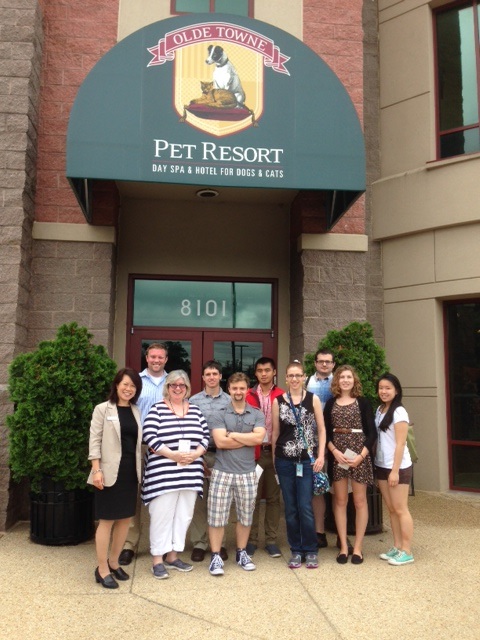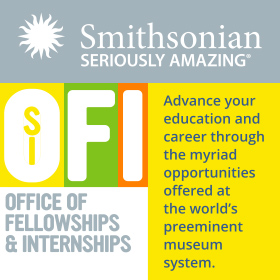OFMR Interns visits Olde Towne Pet Resort!
OMFR (Office of Facilities Management & Reliability) inter, Michael Hoosier talks about his experience joining his fellow interns for a tour of the Olde Towne Pet Resort!
On Thursday June 12th, the interns at the Smithsonian’s Office of Facilities Management and Reliability toured the Olde Town Pet Resort, receiving a behind the scenes tour of its specialized facility. Founded over a decade ago in Springfield, VA, Olde Town serves primarily as a pet boarding service that caters to cat and dog owners and boasts two locations (so far). Their specialty, however, is as a “pet resort” and “doggy daycare” center. To this end, they offer many customizable features such as a “cattery” for “pet parents” to leave their felines, as well as “luxury” and “presidential suites” for dogs. Such unique services require very specialized facilities, which in turn require great thought and planning both in design and in operations. In touring Olde Town Pet Resort, the OFMR interns gained an insightful look into the world of facilities management outside the Smithsonian
The OFMR interns come from all over the country with skills in diverse areas—majors include architecture, philosophy, facilities management, sustainability, and even mechanical engineering. Still, there was something for every interest at Olde Towne. Those who are mechanically inclined might find it interesting just how little this “pooch paradise” smells of dog or cat. This is because the resort has been equipped with a special ventilation system that runs a total indoor air changeover every three to four minutes. This insures that the indoor air quality remains high, preventing any sickness from spreading (the principle danger in most pet boarding operations) and also having the pleasant side-effect of eliminating trace pet odors.

Michael Hossier and fellow interns in front of Olde Towne Pet Resort.
For those that find architecture or design particularly captivating, it would be worth noting that Olde Towne’s Springfield facility is a modification of a previously existing space. The original Olde Town location in Springfield, VA—the location toured by the OFMR interns—was developed from a previous property whose landscape and architecture caused several difficulties when making the transition to a pet resort. When Olde Towne built their second location near Dulles Airport, these features were taken into account and corrected for the new location. In responding to these challenges Olde Towne provided the OFMR interns with a valuable example of flexibility and ingenuity—two necessary features for any facilities manager.
And of course any facility manager would notice that Olde Towne’s careful planning in safety and accident prevention. For example, mirrors line hallways and on doors in strategic locations to prevent collisions; multiple doors and double-gates provide redundancies that guard against the escape of their tenants; and special cleaning products are used to make sure that pets do not accidentally ingest harmful chemicals. As sustainability intern Kyle Friel observed, “All facilities have their own unique problems and challenges that they have to face…The facility must adapt to what it contains to make it as safe and comfortable as possible for the building occupants.” From staff safety to animal well-being (and even escape prevention), Olde Towne’s facility is an example of one designed to meet easily meet the needs of its customers.
Pentagon Memorial
Thanks to the kindness of the Smithsonian Driver James Gaines, Jr., on the way back from Olde Towne Pet Resort the students were treated to a surprise: they were taken to the Pentagon to view the Pentagon Memorial. Commemorating all of those that died in the attack on the Pentagon on September 11, 2001, the memorial consists of 184 illuminated benches, each with their own individual reflecting pool, to commemorate each individual life lost in the attack. The benches are arranged by the age of the youngest victim (three years old), to the oldest at the time of the attack (seventy-one years old). With beautiful young trees growing near each bench, strategic writing intern Mike Hoosier noted that the scene “felt like a living memorial in their honor, rather than a stoic heap of stone.” This is certainly the most notable and inspiring feature of the Memorial—its attention to the individual. To quote Andrew Tse, one of OFMR’s sustainability interns, the Memorial is unique because “Visitors sympathize with each victim, forming a bond with them through various sensory interactions.” For those who were new to DC, it was a powerful and moving experience, and for those locals who have already seen the memorial, it was nice to see it again with fresh eyes.
A wonderful experience enabled by the great team at OFMR!






